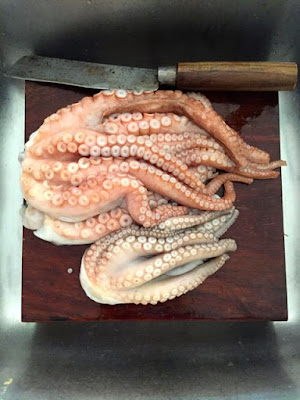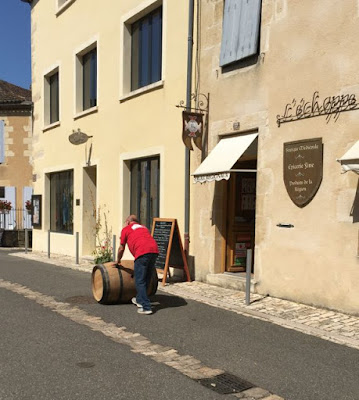Day 1 Cadillac to St Macaire
Ahh, the romance of the grape. The end of day one of our cycling trip out of Bordeaux found us in the delightful old village of St Macaire which is steeped in the history of winemaking with cellars and wine stores on every corner. As we were wheeling our bikes up the cobbled street, in search of our hotel, we even encountered a bloke rolling a barrel of wine down the road - a first for me.
Our stopping place for the night was the charming Hotel Les Feuilles d'Acanthese (Leaves of the Acanthes) a restored 16th century wine cellar with pool and spa in the basement and very good restaurant. However, being Sunday, there was not much open when we arrived so we had a late lunch in the local Pizzeria that had lots of local dishes on the menu, including one of my favourites Gesier Salad - duck gizzard salad. (The first time I had this I had absolutely no idea what I was eating - I just knew it tasted damn good). And when I saw the spa, back at the hotel, I knew that things were really looking up and where I was going to spend the rest of the afternoon.
 Dinner that night in the hotel restaurant did prove to be a treat and this is what I had; mille feuille de tomatoes - a flaky pastry tart with tomatoes, goats cheese and parmesan, followed by the chap on the left with his local sturgeon, lentils and baby carrots, then a delicious salted caramel tiramisu, all washed down with a crisp bottle of rose - yum.
Dinner that night in the hotel restaurant did prove to be a treat and this is what I had; mille feuille de tomatoes - a flaky pastry tart with tomatoes, goats cheese and parmesan, followed by the chap on the left with his local sturgeon, lentils and baby carrots, then a delicious salted caramel tiramisu, all washed down with a crisp bottle of rose - yum. Our comfortable room was part of the converted stone wine cellar with walls two feet thick, blocking out all noise. So, with all that pedalling, soaking, eating and drinking under my belt, I slept like a baby ready for the next day on the bike through the famous Graves and Sauterne vineyards.
The start of Day 2 proved to be a real challenge for we quickly realised that the route was not on the quiet bike tracks we were used to from previous cycling tours ; but instead found ourselves negotiating busy roads and motorways. We tried to be smart, taking various 'shortcuts' and detours. but ended up in a real pickle on the wrong side of a crash barrier with trucks and cars hurtling by. A traveller on foot, with an Eastern Rosella on his shoulder, came to our rescue and helped us negotiate the labyrinth of very dangerous roads and then kindly helped us lift our bikes over the barrier to safety. He was very surprised that I knew what his bird was and, in my halting French, explained that we too came from Australia and flocks of them were regular visitors to our garden. With a broad smile, exchange of pleasantries and a handshake we parted company. That's one of the nicest things about these cycle trips - you never know what delightful chance encounters you may have.
The day improved as we travelled into the countryside of Premier Crux Sauterne with many chateaux dotted on the hillsides, charming villages and old churches, stopping for a while by the ruined castle of Budos (1306) amid the grape vines with the clouds gathering and crows soaring. Our route had become decidedly more rural and we had a few hours of stress free cycling through verdant vineyards with the late summer harvest ripening on the vine.
There was not much going on anywhere, but as we rode into the village car-park in Budos we were surprised to see a large group of pensioners, in a picnic shed, having a cook-up and drinking Ricard at ten o'clock in the morning. They started to wave their arms about and remonstrate with us about something we didn't understand until we realised that we had cycled over their especially prepared gravel boule court - all marked out and ready to go! Quelle horreur.
 On we cycled, through the villages of Sauterne, past its chateau and the imposing Chateau Yquem, Chateau Clos Haut Peyraguey, Chateau de Villandraut and Chateau Rayne Vignau - all normally open for wine tasting but closed on a Monday.
On we cycled, through the villages of Sauterne, past its chateau and the imposing Chateau Yquem, Chateau Clos Haut Peyraguey, Chateau de Villandraut and Chateau Rayne Vignau - all normally open for wine tasting but closed on a Monday. Nothing here would tell you that mind boggling wealth lurks amid the picturesque vine-laden slopes and hollows. The unprepossessing village of Sauternes has a wine shop where bottles of the celebrated Chateau d'Yquem 1990 gather dust on rickety shelves, next to hand written price tags demanding 500 euros for one bottle.
We were now coming out of farmland and into the forests of Landes de Gascogne, heading for our guesthouse in the village of Origne. This Regional Natural Park stretches from here to the coast and is another good reason for visiting Bordeaux and the Gironde - it's very green and you can get away from it all in acres and acres of forest.
This forest covers over 10,000 square kilometres and is, what is known as Atlantic mixed forest - which is mostly maritime pine with oak, alder, beech and holly. Until the nineteenth century this was a vast swampy area and when struggling agriculture was abandoned and a massive reforestation programme was undertaken, draining the swamp and planting thousands of trees.
We were going to have a real contrast tonight after St Macaire, staying in a small guesthouse, La Maison Rose, with our hosts cooking dinner for us - we weren't really sure what to expect but the ominous storm clouds made us hurry on to seek shelter and find out.
The Town Hall in the centre of sleepy Origne
I was expecting rustic sleepiness at La Maison Rose, but what we got was a very chic converted old house and our hosts Corinne and Gerard de Rochefort, of similar age to us, having made a tree/sea change from Paris with accompanying chic decor and comfort. Bonus, the place also has a swimming pool.
Blue hydrangeas were the theme in our room and, initially, I was a little disconcerted by all the guest signs dotted around our very comfortable suite. - an extra 20c for milk in my tea and slices of lemon indeed. It seemed that our stay was to be governed by a lot of rules and regulations and I was beginning to feel slightly uncomfortable - (would I remember to put a coaster under my water glass on the bedside table?). All this fell away when we appeared for dinner and met our hosts, and told by them that we were to take dinner en famille - with them in their gorgeous dining room, and started to swap mutual grandchildren stories with accompanying photos (what would we do without smart phones?). Lovely simple, home cooked dinner of jambon with melon and feta, lamb cutlets with rosemary and a platter of cheese with fresh peaches - perfect.
The dining room at Maison Rose laid for breakfast.























































